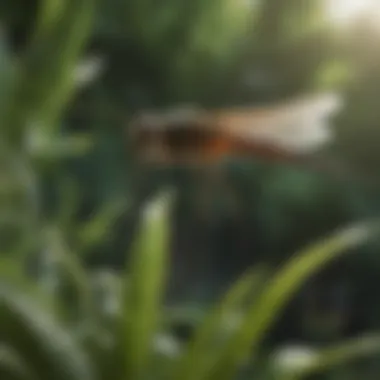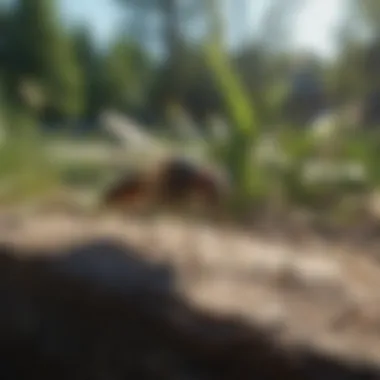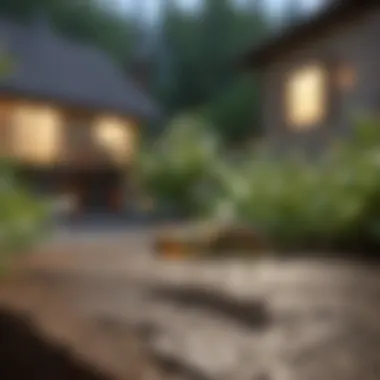Effective Strategies to Eliminate Gnats in Your Yard


Intro
Gnats can be a persistent nuisance in residential yards. Understanding their behaviors and life cycle is crucial to effectively managing their populations. These tiny insects thrive in damp environments, often breeding in overwatered plants, organic debris, or standing water. It is vital to identify and eliminate these breeding sites to achieve a gnat-free space.
By utilizing practical and scientifically-backed methods, homeowners can gain control over gnat infestations. This article will detail various strategies ranging from organic solutions to chemical treatments. Homeowners will learn how to improve their outdoor enjoyment and optimize their gardening activities without the interference of these pests.
Through diligent observation of their habits, proper identification of breeding sites, and timely intervention, one can create a more enjoyable and pest-free outdoor environment.
Understanding Gnats
Understanding gnats is crucial for homeowners seeking to manage and eliminate these pests from their yards. Gnats are small flying insects that thrive in moist environments. They can become a nuisance, particularly during warmer months when outdoor activities increase. Knowing their behaviors, types, and life cycles can significantly assist in developing effective strategies for control. By understanding these elements, homeowners can take proactive measures to prevent infestations and create a healthier outdoor environment.
Types of Gnats
There are several types of gnats commonly found in residential areas. The most prevalent types include:
- Fungus Gnats: These gnats are attracted to damp soil and decaying organic material. They typically infest houseplants but can also be found in yards with high moisture levels.
- Fruit Flies: Often mistaken for gnats, these insects are more commonly associated with ripe or fermenting fruit. They can appear in outdoor compost heaps as well.
- Drain Flies: Also known as moth flies, these gnats often breed in sewage and stagnant water. They are a sign of poor drainage in yards or unwanted standing water.
Recognizing these types not only aids in specific treatment but also helps in identifying and addressing the underlying cause of the infestation.
Life Cycle and Habitat
Gnats generally have a simple life cycle composed of four stages: egg, larva, pupa, and adult. Adult female gnats typically lay their eggs near moisture sources. Once the eggs hatch, the larvae feed on organic matter in the soil or standing water. After a short pupation period, they emerge as adults.
Their preferred habitats include:
- Moist Soil: Areas with overwatering or poor drainage create ideal conditions for fungus gnats.
- Decaying Organic Matter: Piles of leaves or compost can attract gnats seeking food and breeding grounds.
- Standing Water: Any collection of stagnant water, such as in bird baths, gutters, or planters can become a breeding source.
Understanding where gnats thrive enables homeowners to modify their environment accordingly.
Common Signs of Infestation
Detecting gnat infestations early can prevent larger problems later. Common signs include:
- Visible Gnats: Noticing clusters of small flying insects around plants or soil is often the first indication.
- Larval Presence: Checking moist soil or organic matter can reveal small white larvae, signaling a breeding ground.
- Wilting Plants: Plants suffering from root damage due to larval feeding may show signs of stress, including wilting or yellowing leaves.
Understanding these signs helps homeowners implement measures against gnats before they proliferate, ensuring a more enjoyable outdoor space.
Identifying Breeding Grounds
Understanding where gnats thrive is critical for managing their population effectively. By identifying breeding grounds, homeowners can take proactive measures to eliminate potential hotspots for these pests. This section uncovers three main areas that serve as breeding sites for gnats: standing water sources, organic matter accumulation, and plant overwatering practices.
Standing Water Sources
Standing water is among the most common breeding areas for gnats. These insects lay their eggs in moist environments, and stagnant water provides a perfect setting for their continued growth. Common sources include bird baths, clogged gutters, and even small puddles formed from sprinklers.
To mitigate the risk associated with standing water, regularly check your property for such areas.
- Empty bird baths frequently to prevent water accumulation.
- Clean gutters to ensure proper drainage.
- Fill any potholes or depressions in your yard that retain water.
Addressing these issues will substantially lower the likelihood of gnat infestations.
Organic Matter Accumulation


Another contributing factor to gnat breeding is the presence of decaying organic matter. This includes grass clippings, leaf litter, and any plant debris, all of which can create a nutrient-rich environment for gnats.
To reduce the presence of organic materials:
- Regularly rake leaves and dispose of them properly.
- Ensure that you compost materials correctly to avoid attracting gnats.
- Avoid allowing mulch to become overly damp, as this can also create a breeding ground.
Maintaining cleanliness in these areas not only deters gnats but also promotes a healthier yard ecosystem.
Plant Overwatering Practices
Overwatering is a common mistake among gardeners. Excess moisture in the soil promotes gnat reproduction. If plants are watered more than necessary, the soil can become overly saturated. This creates an ideal environment for gnats to flourish.
Consider implementing these practices:
- Check soil moisture before watering to ensure it's needed.
- Use drainage stones or pots with drainage holes to prevent water accumulation.
- Opt for watering techniques that allow for even distribution without saturation, such as drip irrigation.
Incorporating these adjustments will not only help in managing gnat populations but also enhance the overall health of your plants.
Preventative Measures
Preventative measures play a critical role in managing gnat populations in your yard. By addressing potential breeding sites and creating an environment inhospitable to gnats, you can significantly reduce their numbers before they become a nuisance. Using preventive strategies is often more effective and less labor-intensive than combating an established infestation. Focusing on these elements can lead to a healthier yard and a more enjoyable outdoor experience.
Proper Drainage Solutions
Proper drainage is essential in preventing standing water, which serves as a prime breeding ground for gnats. Ensure that your yard has adequate drainage to prevent water accumulation. Here are key steps to implement:
- Inspect and Repair: Regularly check gutters, downspouts, and drains for blockages. Clean them to promote effective water flow.
- Regrade Your Yard: If certain areas tend to hold water, consider regrading these sections to facilitate drainage.
- Install French Drains: These pathways guide water away from desired areas, directing it to a more suitable location.
Adopting these solutions can help dry out areas that would otherwise attract gnats, effectively cutting off their breeding grounds.
Watering Techniques
The way you irrigate your plants greatly influences gnat populations. Overwatering is a common mistake that creates ideal environments for these pests. Consider the following practices to manage your watering techniques:
- Water Wisely: Only water plants when necessary. Make use of soil moisture meters to better gauge when your garden needs watering.
- Deep Watering: This promotes healthy root systems while allowing the topsoil to dry out, which reduces moisture that gnats thrive on.
- Timing Matters: Water early in the morning. This minimizes evaporation while ensuring surfaces can dry out before evening when gnats are most active.
Implementing these measures allows you to maintain vibrant plants while reducing the possibility of gnat infestations.
Maintaining Yard Cleanliness
Keeping your yard clean is another key to preventing gnat issues. Gnats are attracted to decaying organic materials and poor sanitation. Adopting a routine cleaning schedule helps keep these pests at bay. Here are some effective cleaning strategies to consider:
- Debris Removal: Regularly rake leaves and clear away clippings, fallen fruits, or any decomposing matter.
- Composting Wisely: If you have a compost bin, ensure it's maintained correctly. Aerate it frequently to speed decomposition and minimize odors that attract gnats.
- Mulch Management: While mulch can benefit plant growth, too much can retain moisture. Keep mulch layers to a minimum to prevent unnecessary humidity that may attract gnats.
By taking these steps, homeowners can proactively lessen the appeal of their yard for gnats, setting the stage for a gnat-free outdoor environment.
Physical Control Methods
Physical control methods are vital in effectively managing gnat populations. These techniques can target gnats directly, providing immediate relief while minimizing long-term chemical use. They are environmentally friendly and can be easily implemented in various settings. Employing these methods often requires minimal investment and effort, making them accessible to a broad audience of homeowners and gardening enthusiasts. Below, we explore three significant physical control methods: sticky traps, fans and air movement, and manual removal techniques.
Sticky Traps
Sticky traps serve as a straightforward yet effective tool in reducing gnat populations. These traps are designed to attract gnats, where they become ensnared by the adhesive surface. Placing sticky traps strategically around the yard can capture adult gnats and disrupt their breeding cycle.


When selecting sticky traps, consider the following:
- Placement: Position traps near plants and areas where gnats are commonly seen.
- Size and Color: Choose larger traps and bright colors, as these tend to attract more gnats.
- Regular Maintenance: Monitor the traps frequently. Replace them when they become full or lose their effectiveness.
Using sticky traps not only reduces the adult gnat population but also provides visual confirmation of ongoing infestations, allowing for further action as needed.
Fans and Air Movement
Introducing airflow into your garden can create an unfavorable environment for gnats. Gnats, primarily weak flyers, struggle in windy conditions. Installing outdoor fans or utilizing natural wind can dramatically decrease gnat presence.
Here are some considerations:
- Placement of Fans: Position fans at strategic points around your garden or patio to maximize air circulation.
- Fan Speed: Using a higher speed can increase effectiveness, but ensure that plants are not damaged by excessive wind.
- Natural Solutions: If possible, take advantage of natural breezes. Keeping plants well-placed can encourage air flow through spaces, while also deterring gnats.
Overall, creating airflow makes your outdoor area less attractive to gnats, promoting comfortable outdoor experiences.
Manual Removal Techniques
Manual removal techniques are a direct approach to gnat elimination. This includes physically catching gnats or addressing their breeding sites. Action can be taken simply by using a catch glass or similar container to trap visible gnats.
In addition to immediate removal, taking the following steps can further reduce gnat populations:
- Inspect and Clean: Routinely inspect the areas where gnats collect. Cleaning these spaces can prevent additional gnats from returning.
- Remove Breeding Sites: Manually dispose of any decaying organic matter in the yard, as this can serve as a prime breeding ground.
These manual control methods can complement other strategies, producing a comprehensive approach to gnat management.
Biological Control Methods
Biological control methods are pivotal in the realm of pest management, specifically when addressing gnat infestations. This approach leverages natural predators and parasites to reduce pest populations. The advantages of employing biological control are manifold. Not only does it align with environmentally-friendly practices, but it often leads to sustainable pest management solutions. The use of beneficial organisms can minimize the reliance on chemical treatments, which might have unintended consequences on other fauna and flora.
When considering biological control methods, it’s crucial to acknowledge the benefits they bring along. These methods typically result in a more balanced ecosystem, support biodiversity, and reduce chemical residues in your yard. Moreover, biological methods can be more cost-effective in the long run, as they can build up and persist in the environment over time, providing ongoing control against gnats.
Beneficial Insects
Beneficial insects play a significant role in controlling gnat populations. Various species of predatory insects actively hunt and feed on gnats in different life stages. For instance, the larvae of the midge fly are efficient predators of fungus gnats. These insects naturally seek out larvae in moist conditions, which aligns with where gnats thrive.
Additionally, lacewing larvae have voracious appetites for the soft-bodied gnat larvae. Introducing these beneficial insects can significantly enhance the ecological balance in your garden. However, their effectiveness relies on ensuring a suitable environment for them to thrive.
Important Tip: It is best to introduce beneficial insects in early spring when gnat populations begin to increase. This timing allows the predators to establish themselves before a gnat outbreak.
To attract and maintain beneficial insects, consider planting various nectar and pollen-producing plants. These food sources support their development and provide them sustenance outside of gnat predation.
Nematodes as a Solution
Nematodes, particularly Steinernema and Heterorhabditis, emerge as a promising solution against gnats. These microscopic roundworms enter the gnat larvae and release bacteria that kill them. Nematodes are effective because they target the immature stages of gnats when they are most vulnerable.
To successfully utilize nematodes, apply them in the moist soil where gnat larvae are present. It’s best to do this in early morning or late evening when soil temperatures are cooler. This helps in maximizing the nematodes’ effectiveness as they are sensitive to temperature shifts.
Regular monitoring of moisture levels is critical. Nematodes require a moist environment to move and infect their hosts. By maintaining the right conditions and timing, homeowners can effectively reduce gnat populations without reliance on harmful chemicals.
In summary, biological control methods present a viable pathway to manage gnats while promoting a healthy ecosystem. Through the strategic use of beneficial insects and nematodes, homeowners can achieve lasting results in their battle against these pests.
Chemical Control Options


Chemical control options are an integral part of managing gnat populations in your yard. While organic methods are useful, there are situations where chemical solutions are more effective in quickly reducing gnat numbers. These options are particularly beneficial for severe infestations when quicker results are necessary. Choosing the right insecticide can help not only eliminate adult gnats but also target larvae living in breeding sites.
Insecticides Overview
Insecticides designed for gnat control can be broadly categorized into two types: contact insecticides and systemic insecticides.
- Contact insecticides work by physically hitting the insect when sprayed directly. These products are effective in killing adult gnats on contact but do not affect larvae in the breeding sites. Common commercial products include pyrethroids like permethrin and bifenthrin.
- Systemic insecticides are absorbed by plants and can provide protection against gnats feeding on them. Products with imidacloprid can help by killing larvae in plant soil and effectively reducing overall gnat populations.
When selecting an insecticide, it is important to read labels carefully. Look for those that specifically mention gnat control to ensure efficacy. Additionally, pay attention to the active ingredients, as some may be more effective based on your specific gnat type.
Application Guidelines
When applying chemical controls, proper technique is crucial for both effectiveness and safety. Here are some guidelines to follow:
- Timing: Apply insecticides during the evening or early morning when gnat activity is higher. Avoid windy days as this can reduce effectiveness.
- Application Method: Utilize a sprayer or a fogger for widespread coverage. Ensure you are targeting both the plants and the breeding areas in the soil.
- Concentration: Follow the manufacturer’s instructions for dilution ratios. Applying too much can be harmful to non-target species and the environment.
- Frequency: Repeat applications might be necessary according to the product instructions. Observing the effectiveness and adjusting frequency helps manage gnat populations more effectively.
Safety Considerations
Using chemical controls comes with certain risks that require attention. Here are key safety considerations:
- Personal Protective Equipment (PPE): Always wear gloves, long sleeves, and eye protection when handling chemicals. This helps minimize exposure.
- Environmental Impact: Be aware of nearby plants, pets, and beneficial insects. Avoid applying during rainfall or high temperatures, as runoff can occur. This is especially important to prevent harming local wildlife.
- Storage and Disposal: Store insecticides in clearly labeled containers. Dispose of empty containers according to local regulations, as improper disposal can have harmful effects on the environment.
Remember, while chemical controls can provide quick solutions, integrating them with preventive measures and biological controls is ideal for sustainable management of gnat populations.
By understanding the different options and applying them correctly, homeowners can effectively manage and eliminate gnats, leading to a more enjoyable outdoor experience.
Long-Term Management Strategies
Effective long-term management of gnat populations is crucial for sustained results in creating a pest-free yard. It is important to recognize that eliminating these pests is not a one-time effort; rather, it involves ongoing actions that ensure their return is minimized. Implementing a holistic approach focusing on prevention, site management, and continuous monitoring can lead to substantial improvements in your outdoor space without resorting to excessive chemical treatments.
Regular Monitoring and Maintenance
Regular monitoring and maintenance are essential components of any successful gnat management plan. Homeowners should frequently check their gardens and yards for any signs of gnat activity. This includes inspecting plants, soil, and any stagnant water sources. Setting a regular schedule for inspections—ideally weekly—can help identify potential gnat hotspots before they escalate into larger infestations.
In addition to visual inspections, maintaining optimal yard conditions can greatly reduce gnat attraction. Keeping the soil adequately aerated, avoiding excessive watering, and clearing away decaying plant materials are effective practices. Homeowners can also record observations on gnat levels and breeding sites to build a more comprehensive understanding of their gnat control strategies over time.
Seasonal Adjustments in Practices
Adjusting yard care practices according to the seasons is also necessary for effective pest management. Different seasons bring about changes in gnat behavior and environmental conditions. For instance, during warmer months, the potential for gnat breeding increases due to heightened moisture levels and higher plant growth. Homeowners should therefore be proactive in modifying their watering schedules and cleaning routines during these periods.
As autumn approaches, focus on cleaning up leaves and organic debris where gnats can breed. Conversely, winter practices should include protecting overwatered potted plants indoors or ensuring proper drainage to avoid stagnation. By being adaptable and observant, homeowners can create an environment that is less conducive to gnat infestations, while fostering healthy plant growth.
"It is not enough to just eliminate existing gnats; fostering a long-term plan enhances your yard's ecology."
Closure
In the context of managing gnat populations, the conclusion serves as a pivotal element in summarizing effective strategies discussed throughout the article. By presenting a synthesis of key points, readers can reinforce their understanding of the methods available to eliminate gnats from their yards. This not only ensures they recall the necessary steps but also helps them appreciate the holistic approach needed to address the issue.
The benefits of an integrated pest management plan cannot be overstated. Homeowners can combine biological, physical, and chemical methods to create a multi-faceted approach against gnats. Additionally, considering the long-term management strategies discussed allows for sustainable yard practices that will keep future gnat invasions at bay.
Summary of Key Points
- Understanding Gnats: Knowing the types, life cycle, and signs of infestation sets the foundation for effective control.
- Identifying Breeding Grounds: Recognizing sources of standing water and organic matter can minimize ideal environments for gnat populations.
- Preventative Measures: Implementing proper drainage and effective watering techniques can greatly reduce gnat breeding potential.
- Physical Control Methods: Using sticky traps and increasing air movement are practical steps to physically manage gnats.
- Biological Control Options: Introducing beneficial insects and nematodes can help control gnat populations naturally.
- Chemical Control Options: Insecticides can be effective, but understanding application guidelines and safety measures is essential.
- Long-Term Management Strategies: Regular monitoring and seasonal adjustments are key to sustaining a gnat-free environment.
Final Recommendations
To ensure an enjoyable outdoor space, homeowners should adopt a systematic approach to gnat control:
- Combine Strategies: Utilize a mix of methods tailored to your specific yard conditions for maximum effectiveness.
- Stay Informed: Keep updated on the latest pest management practices and resources from trusted sources such as Wikipedia, Britannica, or community platforms like Reddit.
- Keep Records: Track the success of different methods and make adjustments where necessary. This helps in understanding what works best.
- Thorough Cleanliness: Regularly remove organic debris from the yard and manage watering practices to eliminate breeding habitats.
By taking these considerations into account, readers will be well-equipped to manage and eventually eliminate gnats from their yards, contributing to a healthier, more enjoyable outdoor environment.



